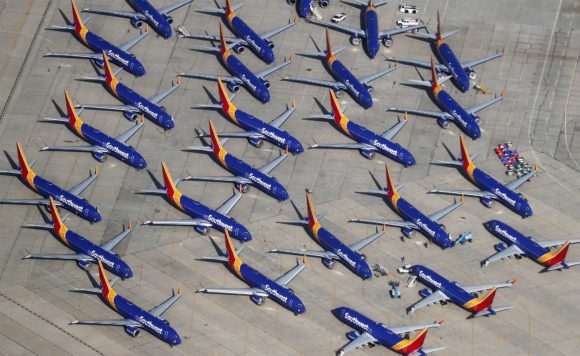An expert panel reviewing how the Boeing Co. 737 Max was certified is expected to cite a breakdown in communication following revelations that aviation regulators didn’t understand key design elements until the first of two deadly crashes of the plane.
The Joint Authorities Technical Review hasn’t found evidence that regulations weren’t followed when the jetliner was approved in 2017, according to a person familiar with its work.
Instead, the approval of the plane with what is now seen as a critical safety flaw even though the U.S. Federal Aviation Administration’s certification process was followed highlights the need for improvements, said the person, who wasn’t authorized to speak about the review and asked not to be named.
One issue is that the design of the Maneuvering Characteristics Augmentation System, the safety feature that drove down the noses of the planes in the two crashes, evolved during the development of the plane and the changes weren’t always communicated adequately, the person said.
Some FAA officials were surprised after the crashes to learn that MCAS had the power to cause a dive and to do so repeatedly, according to the person. Better communication during the process would help identify such risks in the future, the group believes.
One of the issues the group expects to address is that much of the FAA’s certification standards were codified during an earlier era when relatively simpler mechanical failures were the norm. Now, aircraft systems often involve more complex computers that interface with aircraft sensors and the humans at the controls, said the person.
The older standards must be updated to take into account the complex emergencies a failure can cause, according to the person.
Part of the problem was that elements of the system were approved by Boeing employees, not FAA engineers. The FAA routinely designates experts at Boeing and other companies to act as government representatives. Their actions should be made clearer to the FAA leadership, the JATR concluded.
The FAA didn’t comment directly on any expected recommendations. “While the agency’s certification processes are well-established and have consistently produced safe aircraft designs, we welcome the scrutiny from these experts and look forward to their findings,” the FAA said in a statement. “We will carefully review all recommendations and will incorporate any changes that would improve our certification activities.”
Boeing Statement
“We look forward to the findings of the Joint Authorities Technical Review when its work is complete,” Boeing said in a statement on Tuesday evening. “Safety is our top priority when we design, build, deliver and maintain Boeing aircraft.”
The company has repeatedly said it followed certification procedures and informed the FAA about MCAS.
The JATR, formed on April 2, was originally expected to complete its work in 90 days after its first meeting later that month. That deadline has slipped and the panel is hoping to file its conclusions to FAA by later this month or early September.
It’s examining how MCAS was certified and ways to improve the process. It is made up of officials from FAA and NASA along with representatives from Australia, Brazil, Canada, China, Europe, Japan, Indonesia, Singapore and the United Arab Emirates. It is led by Christopher Hart, the former chairman of the U.S. National Transportation Safety Board.
A separate oversight group is reviewing the FAA and Boeing’s work to return the 737 Max to service.
Among the multiple inquiries underway into the 737 Max is a criminal investigation by the U.S. Justice Department.
Portions of the JATR’s work on recommendations were first reported by CNN.
The group’s work isn’t completed, so conclusions may change, the person cautioned.
Was this article valuable?
Here are more articles you may enjoy.


 NYT Asks Judge to Dismiss Trump’s ‘Implausible’ Defamation Suit
NYT Asks Judge to Dismiss Trump’s ‘Implausible’ Defamation Suit  Waymo to Update Software Across Fleet After Major Power Failure
Waymo to Update Software Across Fleet After Major Power Failure  Trump Sues BBC for $10 Billion Over Documentary Edit
Trump Sues BBC for $10 Billion Over Documentary Edit  Cat Bonds Linked to Wildfires Lose ‘Once Untouchable’ Status
Cat Bonds Linked to Wildfires Lose ‘Once Untouchable’ Status 